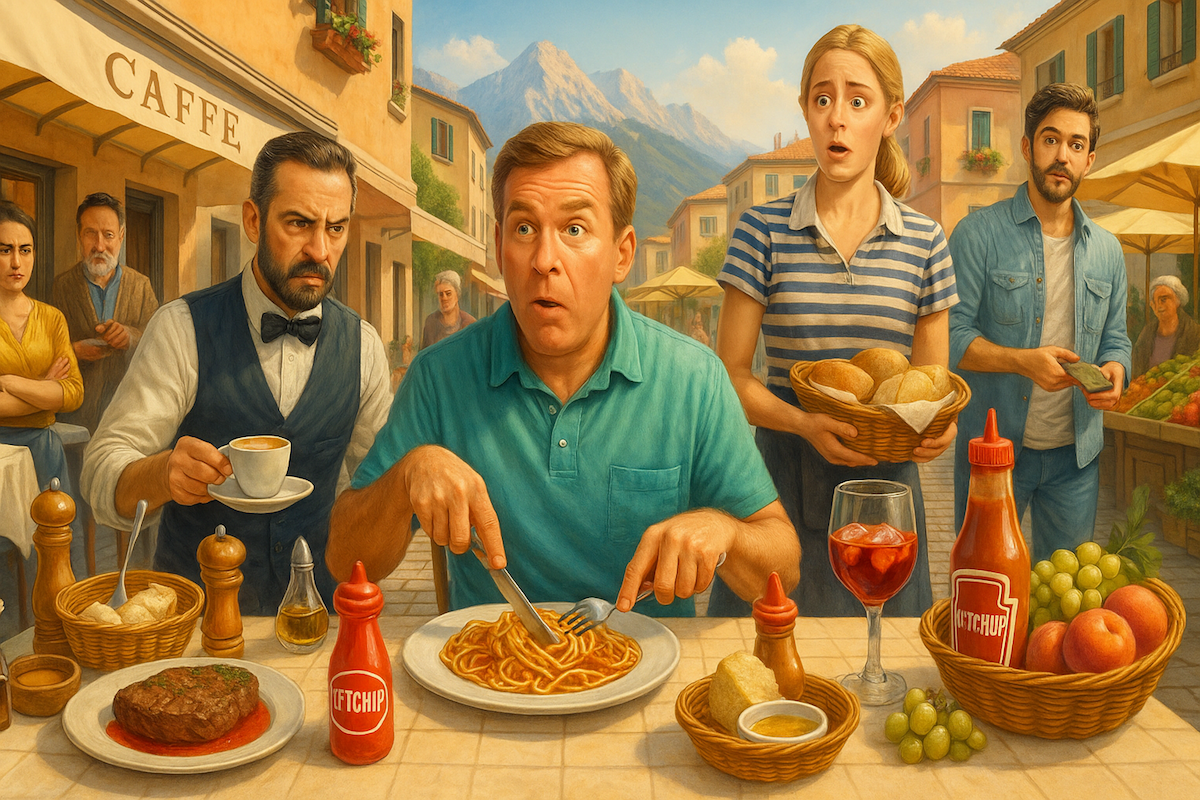From Buttering Bread Wrong to Ordering Cappuccino After Noon, Here’s What Gets You Judged Abroad…
I once asked for ice in my red wine on a hot summer’s day at a café in France.
The waiter didn’t say a word.
He just stared at me like I’d requested a side of bleach with my Bordeaux.
Somewhere in the background, I swear I heard someone say, “Berk!”.
That’s when it hit me.
As Americans, we’re not just tourists in Europe.
We’re walking violations of unwritten food laws.
And the worst part?
We have no idea we’re doing anything wrong.
I learned this the hard way in Spain, too.
I reached for the bread and instinctively dunked it into the olive oil before the meal started.
The older gentleman sitting next to me, who had been warm and chatty just moments before, suddenly went silent.
The kind of silence that says, “You poor, uncultured sob.”
From cappuccinos after Noon in Italy (really after 11am) (guilty) to buttering bread in places where butter doesn’t even belong (France), we are accidentally offending entire civilizations with every bite.
These aren’t just culinary quirks.
They’re quiet codes of conduct, social contracts everyone else seems to understand except us.
So whether you’re planning to order a cappuccino in Italy or browse markets in Georgia or Greece, consider this your pre-flight checklist of what NOT to do.
Because trust me, nothing screams “clueless American” like touching fruit you haven’t bought, cutting your spaghetti, or tipping like you’re starring in “The Real Housewives of Dubrovnik”.
And yes, I’ve done all of it.
You probably have too.
Let’s unpack the damage together.
1. Ordering a Cappuccino After Noon = Must Be a Tourist.
I once made the grave error of ordering a cappuccino after lunch in an Italian café.
That got me a full-body wince from the Italian waiter followed by a silent, theatrical glance at the clock.
In much of Southern Europe, cappuccinos are strictly a breakfast drink.
After noon (after 11am really), it’s all espresso, no milk, no debate.
The logic?
Milk is considered too heavy for digestion post-meal.
To the locals, seeing someone sip on a frothy milk bomb after lunch is like watching someone drink gravy with a straw.
You’re announcing to the world: “I just got here and I have no idea what I’m doing.”
Local Rule: After 11am, switch to espresso and leave the foam fantasies behind, (or for Starbucks).
2. Asking for Ketchup at the Wrong Time? Red Flag!
In France, I once saw a guy at a trendy Paris bistro ask for ketchup to dip his steak in.
The waitress didn’t blink, but the chef came out and stared at him like he’d committed a hate crime.
In France actually, asking for ketchup with anything not resembling a fry is like yelling “I hate your culture” in condiment form.
Ketchup has rules. It lives in a very small neighborhood, and that neighborhood mostly consists of fries.
Maybe a burger on a casual Tuesday.
But steak?
Anything that once required a chef’s attention? You’re in dangerous territory.
Cultural Insight: Unless your food comes in a cardboard box, skip the ketchup.
3. Dipping Bread in Olive Oil Before the Meal? Slow Down, It’s Not a Dip Bar.
In northern Spain, I once reached for a piece of bread and went full tourist, plunged it into the olive oil like I was taste-testing it for a cooking show.
The old man sitting next to me didn’t say a word, but the look he gave me said, “This is why your people eat cheese out of a can.”
In much of Europe, especially in traditional restaurants, bread is not an appetizer.
It’s meant to accompany the meal, not replace it.
And as for that little dish of olive oil and balsamic?
That’s often for tourists. Locals rarely use it.
In fact, some find the whole dipping ritual a bit performative.
Dining Rhythm: Wait for the meal. Bread is the opening act, not the show.
4. Touching the Fruit at the Market? It’s Not a Touch-and-Taste Buffet
In Georgia, I was once, and I thought harmlessly, fondling peaches at a small market in Tbilisi. The vendor nearly swatted my hand with a stick.
In Spain, I reached for a tomato at a neighborhood stall and was immediately met with a curt “Permiso” and a sharp glance.
Lesson learned: you don’t pick, poke, or squeeze unless given explicit permission.
In many European markets, touching the produce is considered rude or even unsanitary.
It’s the vendor’s job to handle it for you.
You’re expected to say what you want, and they’ll select the best based on ripeness, weight, and what kind of relationship you build in 30 seconds of small talk.
Travel Tip: Hands off. Smile, nod, and let the pros do the picking.
5. Buttering Your Bread Automatically? Butter Is Not a Given
I once asked for butter in a bistro in France and the waiter tilted his head like I’d just asked for a Wi-Fi password during a funeral.
In some places, asking for butter with your bread is like asking for a side of mayo with your escargot.
It’s just not a thing.
In many parts of Europe, bread comes as it is. No butter. No side of anything.
Just bread.
You’re supposed to enjoy its texture, its crust, its story. In fact, buttering your bread as a reflex can feel like an insult to the baker.
Dining Reality: When in doubt, taste before you slather.
6. Ice in Your Wine or Beer: Why Are You Watering It Down?
I was in Georgia (the country, not the peach state), and it was 35 degrees Celsius. I asked for ice in my wine. The bartender raised his eyebrows and slowly repeated the word “ice” like I’d just asked if the glass could come with a clown.
In France, adding ice to wine is a sin. In Spain, adding ice to beer is viewed as a cry for help. In most places I’ve lived, ice is seen as something that waters down the experience. Literally. It ruins the integrity of the drink.
Exception: If you’re drinking sangria from a beach bar, fine. But if it’s red wine at dinner, keep the cubes in your soda.
Rule of Thumb: If you wouldn’t water it down at home, don’t start abroad.
7. Over-Tipping (or Tipping at All)? Your Generosity Feels a Bit… Extra
I was in a café in France once and left a 20 percent tip like a good American. The server returned it. I thought he was being humble.
Turns out he thought I was mocking him. Or playing the “Big Shot”.
In much of Europe, tipping is either minimal or already included. Rounding up a bill or tossing in some change is more than enough.
Going full American with your 20 percent tip can actually make locals uncomfortable, or worse, make them feel like you think they need it.
Avoid This: Check if service is included. When in doubt, ask or just round up politely.
8. Cutting Spaghetti? Put the Knife Down and Back Away from the Pasta
At an albergue on the Camino De Santiago in Spain, a group of us, mostly Italians and a few stragglers, solo pilgrims like myself, cooked dinner together.
All was well until one American cut his spaghetti with a knife.
The table went silent.
An Italian set down his fork, stared, and asked, “Why would you do this?”
Another muttered, “It’s not a steak.”
In Italy and most of Southern Europe, cutting long pasta is the equivalent of asking if you can microwave the risotto.
You twirl. That’s it.
No spoon necessary. Just a fork and some wrist coordination.
If you can’t do it, practice. Privately.
Pro Move: Learn the twirl. If you must, use a spoon in private until your skills sharpen.
Have You Broken Any of These Rules? You’re Not Alone.
Let’s be honest. If you’ve traveled abroad and never broken one of these sacred food commandments, either you’re lying or you were raised by a Tuscan grandmother.
We’ve all been there.
That cringe-worthy moment when the entire café pauses and you realize you’re the only one doing something… wrong.
But here’s the good news.
Every fumble is just part of the process. You laugh.
You learn.
And next time, maybe you don’t ask for ketchup with your paella.
So how about you?
Which one of these rules have you broken?
Or better yet, which one still doesn’t make sense to you?
Let’s build a shared survival guide of culinary sins, one faux pas at a time.

David Peluchette is a Premium Ghostwriter/Travel and Tech Enthusiast. When David isn’t writing he enjoys traveling, learning new languages, fitness, hiking and going on long walks (did the 550 mile Camino de Santiago, not once but twice!), cooking, eating, reading and building niche websites with WordPress.

